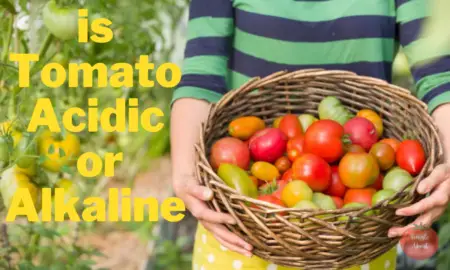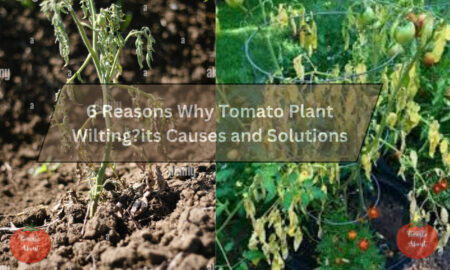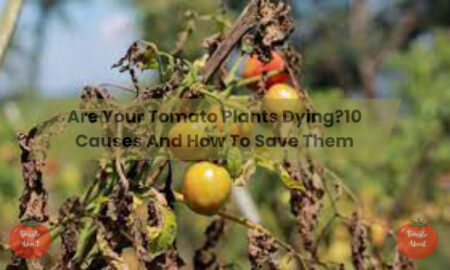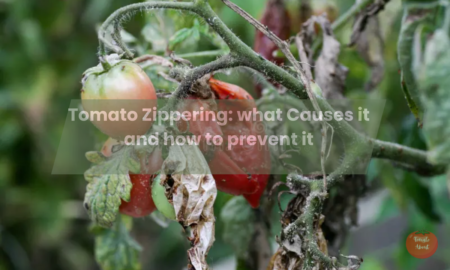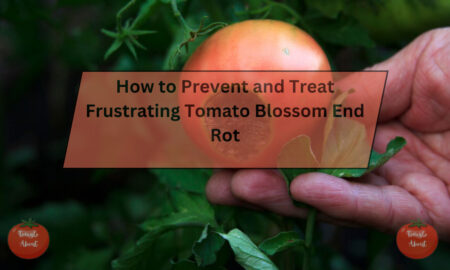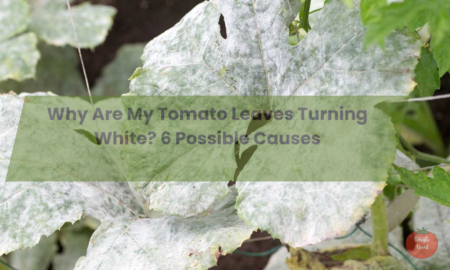Growing tomatoes is fun, but it comes with challenges. One of the biggest is a disease called blight. It can ruin your tomatoes quickly if you’re not careful. But don’t worry – with the right know-how, you can protect your plants.
In this guide, we’ll cover what tomato blight is, how to spot it, and what to do if you find it. We’ll also share tips to help prevent it. Whether you’re new to gardening or have been growing tomatoes for years, this information will help you keep your plants healthy and your harvest bountiful.
Let’s get started and learn how to beat tomato blight!
Tomato blight is a serious fungal disease primarily caused by Phytophthora infestans, affecting both tomatoes and potatoes. It thrives in warm, wet conditions and can lead to significant crop loss if not managed properly. Symptoms often start with spots on leaves, progressing to stem and fruit damage. While treatment is challenging, prevention through proper plant care is key. If blight does strike, remove affected plants promptly to prevent spread.
Key Takeaways
- Tomato blight is a serious fungal disease that can quickly devastate crops
- There are three main types: early blight, late blight, and Septoria leaf spot
- Prevention through proper plant care is key to managing blight
- If blight does appear, quick action is crucial to prevent the spread
- Choosing resistant varieties and practicing crop rotation can help reduce blight risk
- Regular inspection of plants is essential for early detection and management of blight
- Natural methods can help prevent blight, but may not be effective for severe infections
- Some tomato varieties show better resistance to blight, but none are completely immune
- In rainy climates, extra precautions like cover and improved drainage are crucial for blight prevention
What is tomato blight and why should you care?
Blight is a fungal disease that affects not only tomatoes but also other members of the Solanaceae family, including potatoes, eggplants, and peppers. It’s a common nemesis of tomato growers, capable of spreading rapidly and potentially ruining an entire harvest if left unchecked.
As well as threatening your current crop, blight can have long-lasting effects. The fungi responsible for blight can overwinter in soil, potentially affecting future plantings. This makes understanding and managing blight crucial for any serious tomato grower.
What are the different types of tomato blight?
There are three main types of blight that commonly affect tomatoes:
- Late Blight: Caused by Phytophthora infestans, this is often what gardeners mean when they refer to “tomato blight”. It’s the same fungus responsible for the Irish Potato Famine, highlighting its potential for devastation.
- Early Blight: This type is caused by Alternaria solani, a soil-dwelling fungus that thrives in wet, humid conditions.
- Septoria Leaf Spot: While technically not a true blight, this fungal disease (caused by Septoria lycopersici) is often grouped with blights due to similar symptoms and treatment methods.
Each type has its own characteristics and slightly different management approaches, which we’ll explore in more detail.
How can you identify tomato blight?
Identifying tomato blight early is crucial for effective management. Here are the key symptoms to look out for:
- Leaf Symptoms: The initial signs of blight include round brown spots on the leaves, often with light green or yellowish edges. As the disease progresses, leaves may shrivel, turn brown, and collapse.
- Fruit Symptoms: Affected fruits develop brown, sunken spots, and mature fruits may rot quickly. This decay can occur even if the tomatoes are picked early.
- Stem Symptoms: In late blight, you may notice black lesions on stems and a white, fluffy growth containing fungal spores.
- Spread: The disease spreads rapidly through airborne spores, especially during humid weather. It can be carried over long distances by wind and water-splash, making outdoor tomatoes particularly vulnerable.
Each type of blight has its own specific characteristics:
- Early blight typically starts with brown spots on older leaves, with a distinctive bullseye pattern of concentric rings.
- Late blight often appears as irregular gray or brown patches on leaves, with a fuzzy, almost downy appearance on the underside of affected leaves.
- Septoria leaf spot begins with small, round spots starting on lower leaves, which begin yellow, then turn brown, and finally black.
How does tomato blight differ from other fungal diseases?
While tomato blight shares some similarities with other fungal diseases, it has some distinct characteristics that set it apart. Tomato blight, especially late blight, is known for its rapid spread and devastating effects. Unlike some other fungal diseases that may only affect certain parts of the plant, blight can impact leaves, stems, and fruits, potentially destroying entire crops in a matter of days.
Moreover, blight is particularly notorious for its ability to spread quickly through the air. Other fungal diseases might be more localized or spread primarily through soil or direct contact. Blight spores can travel long distances on the wind, making it a threat not just to individual plants, but to entire gardens and even commercial crops in the surrounding area.
Another key difference is the environmental conditions that favor blight. While many fungal diseases thrive in warm, humid conditions, late blight can develop and spread even in cooler weather, making it a threat in a wider range of climates and seasons.
What are the best practices to prevent tomato blight?
Preventing tomato blight is all about creating an environment that’s unfavorable for the fungus to thrive. Here are some best practices to keep your tomatoes blight-free:
- Practice Crop Rotation: Avoid planting tomatoes or related crops in the same spot year after year. This helps break the disease cycle and reduces the buildup of pathogens in the soil.
- Improve Air Circulation: Space your plants properly and prune regularly to ensure good air flow. This helps leaves dry quickly, reducing the humid conditions that blight loves.
- Water Wisely: Water at the base of the plant, preferably in the morning, to keep foliage dry. Consider using drip irrigation or soaker hoses for precise watering.
- Keep Your Garden Clean: Remove plant debris promptly and dispose of any infected material properly. Don’t compost diseased plants.
- Use Mulch: Apply a layer of organic mulch around your plants. This prevents soil (and any soil-borne spores) from splashing onto the leaves during watering or rain.
- Choose Resistant Varieties: While no tomato is completely immune to blight, some varieties show better resistance.
- Monitor Regularly: Check your plants frequently for any signs of disease. Early detection can make a big difference in managing blight.
- Provide Proper Nutrition: Well-fed plants are more resistant to disease. Ensure your tomatoes are getting the right balance of nutrients.
- Consider Protective Sprays: Some gardeners use preventative sprays like copper fungicides or compost tea to boost plant immunity.
Remember, an ounce of prevention is worth a pound of cure when it comes to tomato blight.
Can tomato blight be treated with natural methods?
While severe cases of blight often require chemical fungicides, there are some natural methods that can help prevent and manage milder cases:
- Milk Spray: Some gardeners swear by a spray made from a mixture of milk and water (typically 1 part milk to 9 parts water). The theory is that the proteins in milk can help boost the plant’s immune system.
- Baking Soda Solution: A mixture of baking soda, vegetable oil, and water can help change the pH on the leaf surface, making it less hospitable for fungal growth.
- Compost Tea: This nutrient-rich liquid, made by steeping compost in water, can help boost plant health and resistance to disease.
- Neem Oil: This natural fungicide can help prevent spore germination and slow the spread of the disease.
- Pruning and Sanitation: While not a treatment per se, promptly removing infected leaves and ensuring good air circulation can help manage the spread of blight naturally.
It’s important to note that these natural methods are most effective as preventative measures or for managing very early stages of infection. Once blight has taken hold, more aggressive treatment may be necessary.
What should you do if blight has already infected your tomatoes?
If despite your best efforts, blight does appear in your tomato patch, don’t panic. Here’s what to do:
- Remove Affected Parts: Immediately cut away any infected leaves and dispose of them properly (do not compost). This helps prevent the spread of the disease to healthy parts of the plant and surrounding soil.
- Inspect Regularly: Check your plants frequently, especially during warm, humid weather. Early detection is crucial for managing the disease.
- For early blight or Septoria leaf spot:
- Apply a copper-based fungicide (follow label instructions carefully)
- Increase air circulation by pruning
- Monitor closely and repeat treatment if necessary
- For late blight:
- Remove the entire plant and dispose of it in sealed bags
- Do not compost infected material
- Consider removing nearby plants as a precaution
Remember, it’s better to lose a few plants than risk your entire crop. Be vigilant and act quickly at the first sign of trouble.
Are there any specific tomato varieties that are more resistant to blight?
While no tomato variety is completely immune to blight, some show better resistance than others. Choosing resistant varieties can significantly reduce your risk of blight problems. Here are some tomato varieties known for their blight resistance:
- ‘Mountain Magic’: An indeterminate variety with excellent resistance to both early and late blight.
- ‘Defiant PhR’: A determinate variety with high resistance to late blight.
- ‘Iron Lady’: Known for its resistance to early blight, late blight, and Septoria leaf spot.
- ‘Mountain Merit’: A large, flavorful tomato with good resistance to multiple diseases including late blight.
- ‘Jasper’: A cherry tomato variety with high resistance to early and late blight.
- ‘Matt’s Wild Cherry’: While not completely resistant, this variety has shown good tolerance to blight.
- ‘Legend’: An early-maturing variety with some resistance to late blight.
Remember, even resistant varieties can succumb to blight under severe conditions, so it’s important to combine resistant varieties with good cultural practices.
How can I protect my tomato plants from blight if I live in a rainy climate?
Living in a rainy climate can indeed make blight prevention more challenging, but there are several strategies you can employ:
- Use Cover: If possible, grow your tomatoes under some form of cover like a polytunnel, greenhouse, or even a simple clear plastic roof. This can help keep rain off the leaves.
- Improve Drainage: Ensure your soil has excellent drainage. Consider raising your beds or planting in containers if soil drainage is poor.
- Increase Spacing: Give your plants extra space in rainy climates to improve air circulation.
- Prune Aggressively: Remove lower leaves and suckers regularly to improve air flow and reduce humidity around the plant.
- Use Preventative Sprays: In rainy climates, you may need to use fungicidal sprays more regularly. Always follow the manufacturer’s instructions.
- Plant at the Right Time: Try to time your planting to avoid the rainiest part of the season if possible.
- Choose Extra-Resistant Varieties: In very wet climates, it’s even more important to choose varieties with high blight resistance.
Remember, in challenging climates, a multi-pronged approach is often necessary. Combine as many of these strategies as possible for the best results.
Long-term Management of Tomato Blight
In addition to the preventive measures, long-term management of tomato blight involves:
- Dispose of Infected Plants: Infected plants should be buried deeply or burned to eliminate the pathogen from your garden. Clean all gardening tools and supports to prevent cross-contamination.
- Soil Health: Maintain healthy soil through proper fertilization and organic matter addition. Healthy soil promotes strong plants that are more resistant to disease.
- Learn from Each Season: Keep a garden journal to track blight occurrences and the effectiveness of your management strategies. This can help you refine your approach over time.
Conclusion
Tomato blight can be a gardener’s nightmare, but with the right knowledge and practices, it doesn’t have to spell the end of your tomato-growing dreams. By understanding the different types of blight, recognizing early symptoms, and implementing good prevention strategies, you can significantly reduce your risk of blight problems.
Remember, healthy plants are your best defense against disease. Focus on providing the right growing conditions, practice good garden hygiene, and stay vigilant. With these tools in your gardening arsenal, you’ll be well-equipped to handle whatever challenges come your way in your tomato-growing journey.
FAQ
Can I eat tomatoes from plants with blight?
While fruits from blighted plants aren’t harmful to eat, they may have an off-flavor. It’s best to remove affected fruits to prevent further spread of the disease.
How long can blight survive in soil?
Blight-causing fungi can survive in soil for several years, which is why crop rotation is so important.
Can blight spread to other plants in my garden?
Yes, blight can spread to other members of the Solanaceae family, including potatoes, eggplants, and peppers.
How quickly can blight spread in ideal conditions?
Late blight can spread rapidly in warm, humid weather, potentially affecting an entire crop within 7-10 days.

